Related Research Articles

Amphipoda is an order of malacostracan crustaceans with no carapace and generally with laterally compressed bodies. Amphipods range in size from 1 to 340 millimetres and are mostly detritivores or scavengers. There are more than 9,900 amphipod species so far described. They are mostly marine animals, but are found in almost all aquatic environments. Some 1,900 species live in fresh water, and the order also includes the terrestrial sandhoppers such as Talitrus saltator.

The Aldabra giant tortoise is a species of tortoise in the family Testudinidae. The species is endemic to the islands of the Aldabra Atoll in the Seychelles. It is one of the largest tortoises in the world. Historically, giant tortoises were found on many of the western Indian Ocean islands, as well as Madagascar, and the fossil record indicates giant tortoises once occurred on every continent and many islands with the exception of Australia and Antarctica. Many of the Indian Ocean species were thought to be driven to extinction by over-exploitation by European sailors, and they were all seemingly extinct by 1840 with the exception of the Aldabran giant tortoise on the island atoll of Aldabra. Although some remnant individuals of A. g. hololissa and A. g. arnoldi may remain in captivity, in recent times, these have all been reduced as subspecies of A. gigantea.
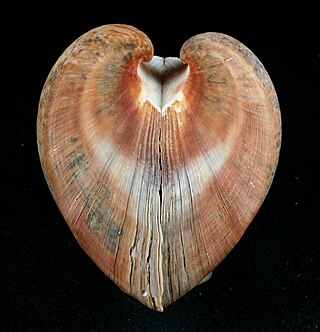
The false ark shells (Cucullaea) are a small genus of marine bivalve molluscs related to the ark clams. The genus is the only member of the family Cucullaeidae.

Stichodactyla gigantea, commonly known as the giant carpet anemone, is a species of sea anemone that lives in the Indo-Pacific area. It can be kept in an aquarium but is a very challenging species to keep alive and healthy for more than 3–5 years.

Condylactis gigantea is a tropical species of ball anemone that is found in shallow reefs and other shallow inshore areas in the Caribbean Sea – more specifically the West Indies – and the western Atlantic Ocean including southern Florida through the Florida Keys. It is also commonly known as: giant Caribbean sea anemone, giant golden anemone, condylactis anemone, Haitian anemone, pink-tipped anemone, purple-tipped anemone, and Florida condy. This species can easily be seen growing in lagoons or in inner reefs as either individuals or loose groups, but never as colonies. They are often used as a model organism along with others in their genus for facultative symbiosis with monocellular algae.

Lottia gigantea, common name the owl limpet, is a species of sea snail, a true limpet, a marine gastropod mollusc in the family Lottiidae. Its genome has been sequenced at the Joint Genome Institute.

Cidaroida is an order of primitive sea urchins, the only living order of the subclass Perischoechinoidea. All other orders of this subclass, which were even more primitive than the living forms, became extinct during the Mesozoic.
S. gigantea may refer to:
T. gigantea may refer to:
Merica gigantea is a species of sea snail, a marine gastropod mollusk in the family Cancellariidae, the nutmeg snails.
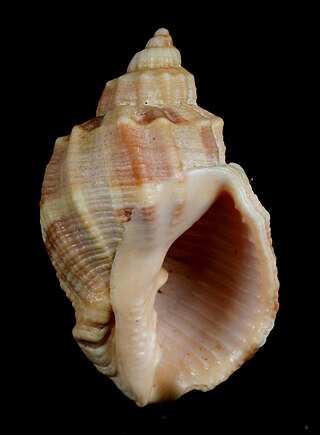
Sydaphera is a genus of sea snails, marine gastropod mollusks in the family Cancellariidae, the nutmeg snails.
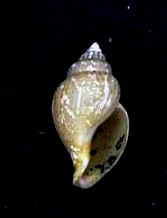
Obesotoma is a genus of sea snails, marine gastropod mollusks in the family Mangeliidae.
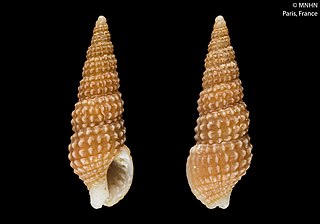
Chauvetia gigantea is a species of sea snail, a marine gastropod mollusc in the family Buccinidae, the true whelks.

Emarginula gigantea is a species of sea snail, a marine gastropod mollusk in the family Fissurellidae, the keyhole limpets.
Subcancilla gigantea is a species of sea snail, a marine gastropod mollusk in the family Mitridae, the miters or miter snails.
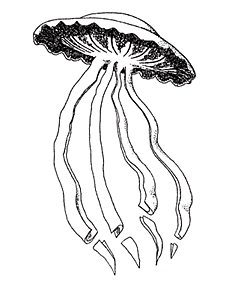
Stygiomedusa gigantea, commonly known as the giant phantom jelly is a part of the monotypic genus of deep sea jellyfish, Stygiomedusa. This is in the Ulmaridae family. With only around 110 sightings in 110 years, it is a jellyfish that is rarely seen, but believed to be widespread throughout the world, with the exception of the Arctic Ocean.
Takasagovolva honkakujiana is a species of sea snail, a marine gastropod mollusk in the family Ovulidae, the ovulids, cowry allies or false cowries.
Takasagovolva is a genus of sea snails, marine gastropod mollusks in the family Ovulidae.

Stellaria gigantea is a species of large sea snail, a marine gastropod mollusk in the family Xenophoridae, the carrier shells.
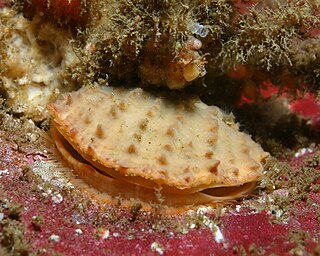
Crassadoma is a genus of rock scallops, marine bivalve molluscs in the family Pectinidae. It is monotypic, the only species being Crassadoma gigantea, the rock scallop, giant rock scallop or purple-hinge rock scallop. Although the small juveniles are free-swimming, they soon become sessile, and are cemented to the substrate. These scallops occur in the eastern Pacific Ocean.
References
- ↑ Takasagovolva gigantea Azuma, 1974 . Retrieved through: World Register of Marine Species .